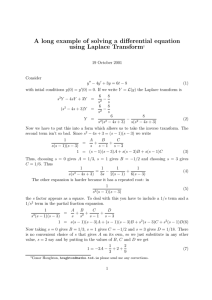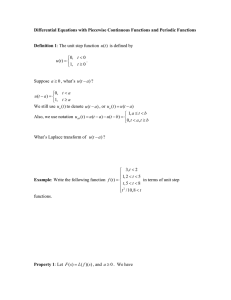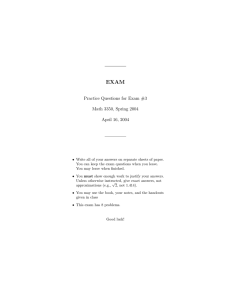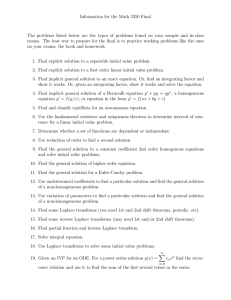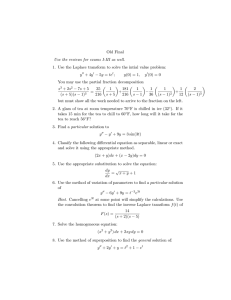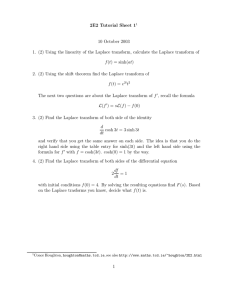Document 10485519
advertisement
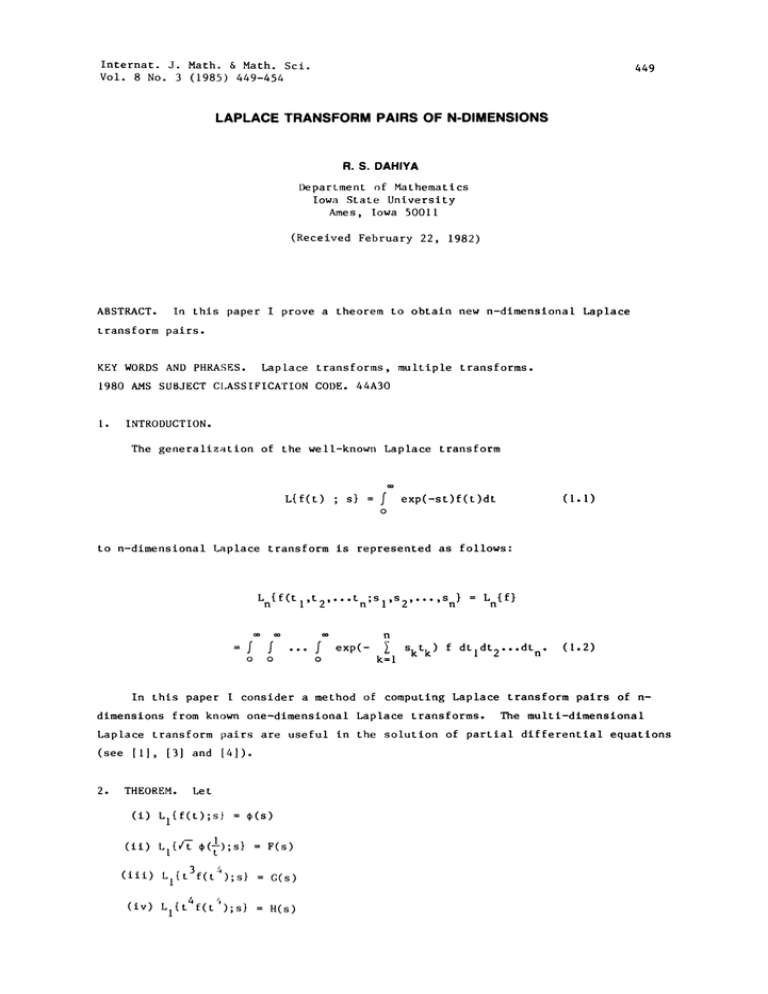
Internat. J. Math. & Math. Sci.
Vol. 8 No. 3 (1985) 449-454
449
LAPLACE TRANSFORM PAIRS OF N-DIMENSIONS
R. S. DAHIYA
Department of Mathematics
lowa State University
Ames, Iowa 50011
(Received February 22, 1982)
ABSTRACT.
In this paper I prove a theorem to obtain new n-dimensional Laplace
transform pairs.
KEY WORDS AND PHRASES.
Laplace transforms, multiple transforms.
1980 AMS SUBJECT CI.ASSIFICATION CODE. 44A30
INTRODUCTION.
The generalization of the well-known Laplace transform
L{f(t)
s}
(1.1)
exp(-st)f(t)dt
o
to n-dimensional Laplace transform is represented as follows:
L {f(t ,t
n
2’’’ .t n -s I’ s 2’’’’’ s n}
o
f
o
f
o
exp(-
.
k--I
Skt k)
f
Ln{f}
dtldt2...dtn.
(1.2)
In this paper I consider a method of computing Laplace transform pairs of ndimensions from known one-dimenslonal Laplace transforms.
The multi-dlmenslonal
Laplace transform pairs are useful in the solution of partial differential equations
(see [11, [3] and [4]).
2.
THEOREM.
(i)
Let
ut{f(t);s}
(s)
(ii)
L|{/t {( )’s}
(iii)
Ll{t3f(t );s}
Ll{t4f(t/*);s}
(iv)
4
F(s)
O(s)
U(s)
R. S. DAHIYA
450
and let
f(t),
(0,(R)).
Then
n
1(
|"’’
n
F.
ICtl’’’tn) I/2
2107
n+l
2
G( +...+ /n
(Sl...Sn)
n
be continuous and absolutely integrable in
3
+
t
L
t3f(t4), t4f(t 4)
(),
+’’’+
+
I/2
297
J_2
n) ];sl ..... Sn
n+l
2
4n
+..+
(sl...sn)
I/2
H(s
+...+ /s
(2.1)
2,3,4...
provided the integral on the left exists as an absolutely convergent in each of the
variables.
PROOF:
From (i), we have
b(-)
--
f e-t/sf(t)dt
]
o
O(t1-)
f
e-U/tf(u)du.
(0,).
(2.2)
o
Let us multipIy both sides of (2.2) by e
the limits
e-U/Sf(u)du,
o
-st,
Re(s)
>
O, and Integrate between
Then on changing the order of integrations on the resulting
right hand integral (permissible by Fubini’s theorem, on account of absolute
convergence), we obtain
-
S:-St4- (tl--)
o
dt=
S
f(u)
o
So
/-
e-St-U/t dtldu.
We then evaluate the inner integral on the right (see [5], page 22) and use (il) on
the left to get the following result:
F(s)
f
(1 +
2s)s-3/2e-2uSf(u)du,
o
s
3/2
F (s)
f
(1 + 2us)e
2uSf(u)du
(2.3)
o
Next let us write (2.3) in the form
256/-
f
f(u)du + 64-
e
o
2
4
L024-
S
o
e
i 3f(u4)du+256
+...+
f (I
tl
o
)e
n
u
(_...L
+
t
.+
)e
n
2
u
(u4)d
.
LAPLACE TRANSFORM PAIRS OF N-DIMENSIONS
(tl...tn)-I/2exp(
We multiply both sides by
to
t
(0,)
between the limits
i
451
siti)
integrate with respect
and then change the order of integrations in the
resulting integral on the right, permissible by Fublni’s theorem, on account of
absolute convergence.
This gives
(_i+
t
f
o
ep(-, siti)
o
u3f(u 4)
I024/
+
256-
u
n
F[
I/2
(tl...t n)
u
exp(-s t
I
o
...+)3
I
)dt
Ct n
4
5f (u)
+
-
tl3/2t 2 ...t n
o
exp(-sftf
Ct
t
2
n
exp(-Sntn-
2t’ 3 ...t n
l)d t I’’" dt
u
2
,l. _k +’’’+
u
4t
2)
dt
+...+
du
tf
]dtl’" .dt n
t
du
3r
t
...tn_ In
(2.4)
Evaluating the inner integrals on the right by (see [5], page 22, results 6 and
7)
we get
(--i +...+ i2-) 3
n
(t
-
tn
1/2
64
(2.5)
LI
n
n+
1024
(Sl...s n)
n+l
+ 512
(/-I +
(s
1"
-1/2
’Fn)
"’+
Sn)
fo
11/2--
exp(-u
I
o
i)u3f(u4) du
exp(- u
.
’-i)u4 f (u 4)du.
on the right hand side of
The proof is complete if we use (iii) and ((iv)
(2.5).
3.
u-dimensional Laplace transform pairs.
APPLICATIONS:
Let f(t)
t
v
so that
LI{/- ((-),s} Ll{r(v+l)t
Ll{tV -s}
v+3/2
;s}
I" (v+l)
s
v+l
(s).
I’(v+l)I’(v+5/2)
x
v+5/2
Then
F(s)
452
R.S. DAHIYA
Ll{t3f(t4);s}
Ll{t
Ll{t4f(t4);s}
Ll{t
L {(t
n
I"
4v+3
r (4v+4)
;s}
s
4v+4
G(s),
4v+4
r(4v+t)
4v+5
;s}
Hence from (2.1), we get
H(s).
s
..tn)-I/2(-iftl +’’’+ n)
2v-2
,s
;s
n}
n+l
2
F(4v+4)
82v-7r(v+l)r(v+5/2)
n+l
2
r(4v+5)
82v-6F(v+l)r(v+5/2)
f
Similarly if we take
(Sl’’’Sn)-l/2(l +’’’+ 4--)-4V-4n
(sl’’’Sn>-I/2(’/’l +’’’+ /n)-4v-4
(3.)
to be the following
tc-I oF3(a,b,c;kt)
t
v
exp(-
f(t)
j2v (,rF
t
p q
[(b)
t
in the theorem, then we obtain the following n-dimenslonal Laplace transform pairs:
(t
n
27
l...tn)_l/2
(_J.l
+...+
t
n+l
2
1"(4c)
(s
1 (4c+1) (s
82Cr(c)r(c+3/2)
..s
/
n
n
)4c 4F3
1-1/2
+...+
64k_
t
l’’’Sn)-l/2
82Cr(c)r(c+3/2)( +...+
n+l
2
+ 3/2;
)2c IF2
/nn)4C
4F3
n
2c,2c+1/2 2c+],2c+2;
2c+1/2,2c+1,2c+3/2,2c+2
256k
(/s-’ +...+ /--)4n
a,b,c;
Re(c)
2__5 6_k_
>
0.
(3.2)
453
LAPLACE TRANSFORM PAIRS OF N-DIMENSIONS
L
n12
2
r(4v+4)( "’Sn) -112 exp./
s +...+ /n)
2v-4r(2v-5)
n12
exp(’(I’I +’’’+ In) 2)D-ov-.""(-=if
,n
(I’..=d +’’’+ I-))
2v-5/2r(2v+3) (s .., I/2
q
>-
Re(v)
L
n
(tl’’" a)-1/2(_1_tl
+...+
_if
(_,I
64 t +’’’+
2+ 1)-1
I
__)3
n
v
(l-I +’’’+ In)2
+
"
.03[ (I
L
(_.J_l
+’’’+
t
v
_y.v
8I’
+...+
p+2Fq
2a+2
2+ l);s I’
In)2
4’ 2 +
2
+’" "+
"in
n
2
sin(v+3/2)(/l
v-73/Ssin( v-I/2)(Sl...Sn
G50
n
Sn
I/2
n_+
2
s
(3.3)
)v/2
2 -9in(v_i/2)(s i...Sn)
G50
--
2
Qv-I/2 (’-;-(
b t
+...+
sin(v+3/2)(
I.
9
4
v+3
2
’-n
I/2
v
3
4
v
4’
4’
4
(a) ,a+l,a+512;
(b);
,2
64
(1__._
t +’’’+
v
v 9
4}
(3.4)
._
n+!
a
2
I,(4a+4) (s
1... s
)-1/2
4(8)2a+lr(a+l)r(a+5/2)(/ +...+ ,/’n) 4a+4
p+4
Fq
[(a),2a+2,2a+5/2,2a+3,2a+7/2;
256
(b);
(/s
n+l
2
r(4a+5)(Sl...Sn)_
Fq
/n) 4
-1/2
82a+2F(a+l)F(a+5/2)(I +...+
p+4
+...+
(a) ,2a+3,2a+7/2,2a+4,2a+9/2;
(b)
Re(a)
I=-) 4a+4
256
(I
>
+...+ Is
1.
)4
(3.5)
R. S. DAHIYA
454
REFERENCES
[i]
Ditkin, V.A., and Prudnikov, A. P., Operational calculus in two variables and
its application (English translation Pergmon Press. London (1962).
[2]
Erdelyi, A. W. Magnus, F. Oberhettinger, F. Tricomi, Tables of Integr@
Transforms. Vol.l, McGraw-Hill, New York (1954).
[3]
Estrin, T. A. and Higgins, T. J., Solutions of boundary value problem by
multiple Laplace transformation. Jour. Frank. Inst. 252 (1951), 152-167.
[4]
Jaeger, J., The solution of boundary value problems by a double Laplace
transformation. Bull. Amer. Math. Soc. 46 (1940), 687-693.
[5]
Roberts, G. E. and Kaufman, H., Table of Laplace transforms.
Company
1966).
W. B. Saunders
